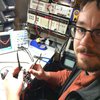Things I've Built
Underwater Temperature sensor chain
Uses a re-configurable chain of DS18B20 one wire sensors to create a poor-mans thermistor string for underwater deployments. Calibration is one challenge, as is the ever present threat of epoxy failure.
Tide Level Sensor
Using MS58xx series sensors, recorded underwater pressure and derived tide height by subtracting the barometric record from a second matched sensor on the surface. Also recorded water temperature with a DS18b20.
Water flow sensor
Operates as a freely swinging pendulum, where drag induced tilt is measured as a proxy for flow velocity. Used in cave environments where low ceilings and floating crud interfere with other flow measuring instruments.
Logging Rain Gauge
Funnels water drops onto an accelerometer in "tap sensing" mode to generate interrupts which update a counter. This is a housing mod. for the cave water drip sensors I came up with for my wife's research.
Masons Hygrometer
Uses DS18b20 sensors to measure dry vs wet bulb temperature differences and derive relative humidity.
Projects I Like & Follow
Share this profile
ShareBits
Become a Hackaday.io Member
Create an account to leave a comment. Already have an account? Log In.
thanks for the follow on the SunLeaf, big updates are coming this week!!!
Thanks for following my Solar car of wood project! Your water measuring devices, especially the one for tides, look very useful indeed. Best of luck...and skill!
Edward thanks for following along with the #The FireVolt Project. Cave Diving seems to me, the epitome of challenge and adventure. One can only imagine the things you'll discover along the way. Exciting stuff! I salute the projects you are working on. Beautiful portfolio to boot!
Media tropes have people believe that cave diving is filled with heart pounding excitement, but in fact it's fairly zen most of the time. Banal stuff, like lumping your tanks through the jungle, can be more dangerous than the actual dives. But I guess perspective is always relative. I've been lucky enough to work beside ‘real’ researchers & explorers, and they talk about the amazing things they do as if they were deciding what to buy at the grocery store:
http://www.savagechickens.com/2008/11/work-is-easy.html
I'm not saying they don't love it, but for most of them the conceptual discoveries are the truly exciting moments: the ones that really motivate them. One of our friends recently described getting the first look at a good data set "like opening the best present ever on Christmas". I hope my humble bots can give that feeling to many more people.
The portfolio hasn't had much attention lately, as the project has expanded to take up all my mental bandwidth. But I think there are enough spatial challenges sorting out the housing & physical layout that the right side of my brain has not completely rebelled…yet :-)
Thanks for following uRADMonitor! One of my other projects was semifinalist in last year's Hackaday prize, check it out here: https://hackaday.io/project/1662-global-radiation-monitoring-network
I just went through some heavy lifting (for me at least) to calibrate the magnetometers in my flow sensors:
http://edwardmallon.wordpress.com/2015/05/22/calibrating-any-compass-or-accelerometer-for-arduino/
And I am still learning how to include the compass data in the force vector calculations (ie: combined with the acclerometer data) so I'd love to hear any suggestions you have there (suitable for beginners)
We do see significant temperature influence on some sensors (Honeywell especially). I am probably going to end up building a jig to calibrate the sensor for science use. In the 3D compass we just wanted to display the field direction with a coarse LED matrix, so the calibration wasn't as important. Wanting to look at things like diurnal variations in the magnetic field though will require calibration and compensation. Also over sampling since they are small! Your project looks very interesting!
For us temp is not too much of a problem because cave environments are very thermally stable. But the batteries have a huge influence on the magnetometers so there is a real question about how well I can calibrate given how close the cells are to the sensor. The next round of tests will hopefully answer that question.
Yeah, anything changing in the system can be a real pain. We'll stay in touch about this and I'll follow the blog!
Hello,
Thanks for following my PV Hot Water production projetct.
Regards,
Michel

 Ed Mallon
Ed Mallon JRodrigo
JRodrigo adriancubas
adriancubas JP Gleyzes
JP Gleyzes jean
jean Tim Wilkinson
Tim Wilkinson Cees Meijer
Cees Meijer Benjamin Prescher
Benjamin Prescher Robin Fröjd
Robin Fröjd strange.rand
strange.rand ravi butani
ravi butani Andy
Andy Jan
Jan John Opsahl
John Opsahl GOAT INDUSTRIES
GOAT INDUSTRIES Lex Kravitz
Lex Kravitz Ozz
Ozz







Thanks Edward, again